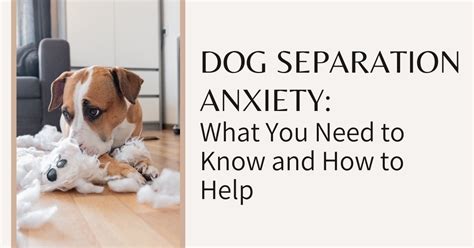Introduction
Dogs, our beloved companions, form an unbreakable bond with us. But when we leave them alone, they may experience a range of emotions, from mild anxiety to severe distress. Understanding the difference between dog separation anxiety and loneliness is crucial to providing the best care for our furry friends.

Dog Separation Anxiety: A Silent Epidemic
What is Dog Separation Anxiety?
Dog separation anxiety (SA) is a complex condition characterized by excessive distress and anxiety when the dog is separated from its owner or primary caregiver. Symptoms can vary but often include:
- Pacing, panting, or whining
- Destructive behaviors (e.g., chewing furniture, digging)
- House soiling
- Excessive barking or howling
Prevalence and Causes
According to the American Veterinary Medical Association (AVMA), approximately 14% of dogs experience SA. The exact causes are unknown, but genetic predisposition, past traumatic experiences, and learned behaviors can contribute to its development.
Loneliness: A Natural Response
What is Dog Loneliness?
Dog loneliness is a natural response to being left alone, especially for social breeds that crave companionship. They may exhibit signs of sadness, such as:
- Sleeping more
- Loss of appetite
- Lack of interest in activities they normally enjoy
Differences from Separation Anxiety
Unlike SA, loneliness does not normally cause destructive or harmful behaviors. Loneliness is a temporary state that may occur when the dog is left alone for short periods. However, prolonged or chronic loneliness can lead to stress and behavioral problems.
Distinguishing Between SA and Loneliness
Important Similarities
-
Both SA and loneliness can involve stress and anxiety.
-
They share symptoms such as pacing, whining, and decreased appetite.
Key Distinctions
-
Severity: SA is more severe, leading to destructive behaviors and potentially harmful reactions.
-
Duration: SA persists even for short separations, while loneliness usually resolves within a few hours.
-
Context: SA is triggered by the absence of the owner, while loneliness can occur even when other people are present.
Tackling Dog Separation Anxiety
Treatment Options
Managing SA requires a multi-faceted approach involving:
-
Training and Behavioral Therapy: Gradual desensitization and socialization techniques help dogs build confidence and reduce anxiety.
-
Medication: In severe cases, anti-anxiety medications can provide relief and support behavioral therapy.
Prevention Strategies
-
Establish a Regular Routine: Predictable schedules create a sense of security and reduce anxiety.
-
Provide Mental and Physical Stimulation: Engage your dog in interactive games, puzzle toys, and regular exercise.
-
Gradual Separation: Start by leaving your dog alone for short periods and gradually increase the duration over time.
Addressing Dog Loneliness
Coping Mechanisms
-
Provide Companionship: Dogs benefit from interaction with other dogs or family members.
-
Create a Safe and Comfortable Space: Make sure your dog’s environment is calming and has a cozy place to retreat to.
-
Consider Daycare or Dog Walking: Professional services can provide companionship and exercise while you’re away.
Common Mistakes to Avoid
-
Ignoring the Problem: SA and loneliness can worsen if left untreated.
-
Punishing the Behavior: Punishment only escalates anxiety and makes the problem worse.
-
Over-Protecting the Dog: While it’s important to provide support, excessive coddling can reinforce the anxiety.
A Step-by-Step Approach to Managing SA
-
Identify the Triggers: Observe your dog’s behavior and determine what situations or events trigger their anxiety.
-
Create a Treatment Plan: Consult with a veterinarian or certified animal behaviorist to develop a customized treatment plan.
-
Be Patient and Consistent: SA management takes time and effort. Stick to the plan and provide consistent support.
-
Monitor Progress: Keep track of your dog’s behavior and make adjustments to the plan as needed.
Conclusion
Dog separation anxiety and loneliness are distinct conditions that can impact the well-being of our beloved pets. By understanding the differences, identifying the symptoms, and implementing effective management strategies, we can help our dogs overcome these challenges and live happy and fulfilling lives.
Tables for Reference
| Comparison Metric | Separation Anxiety | Loneliness |
|---|---|---|
| Severity | Severe | Mild |
| Duration | Persistent | Temporary |
| Context | Absence of owner | Any situation where the dog is left alone |
| Destructive Behaviors | Yes | No |
| Treatment Options | Separation Anxiety | Loneliness |
|---|---|---|
| Training and Behavioral Therapy | Yes | Yes |
| Medication | May be necessary | Not typically necessary |
| Companionship | Helpful but not always sufficient | Essential |
| Prevention Strategies | Separation Anxiety | Loneliness |
|---|---|---|
| Regular Routine | Yes | Yes |
| Mental and Physical Stimulation | Yes | Yes |
| Gradual Separation | Yes | Not necessary |
| Common Mistakes to Avoid | Separation Anxiety | Loneliness |
|---|---|---|
| Ignoring the Problem | Yes | Yes |
| Punishing the Behavior | Yes | Not as applicable |
| Over-Protecting the Dog | Yes | Can be a factor |





















